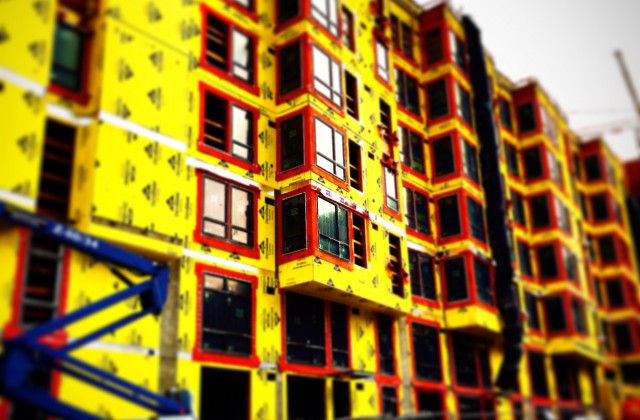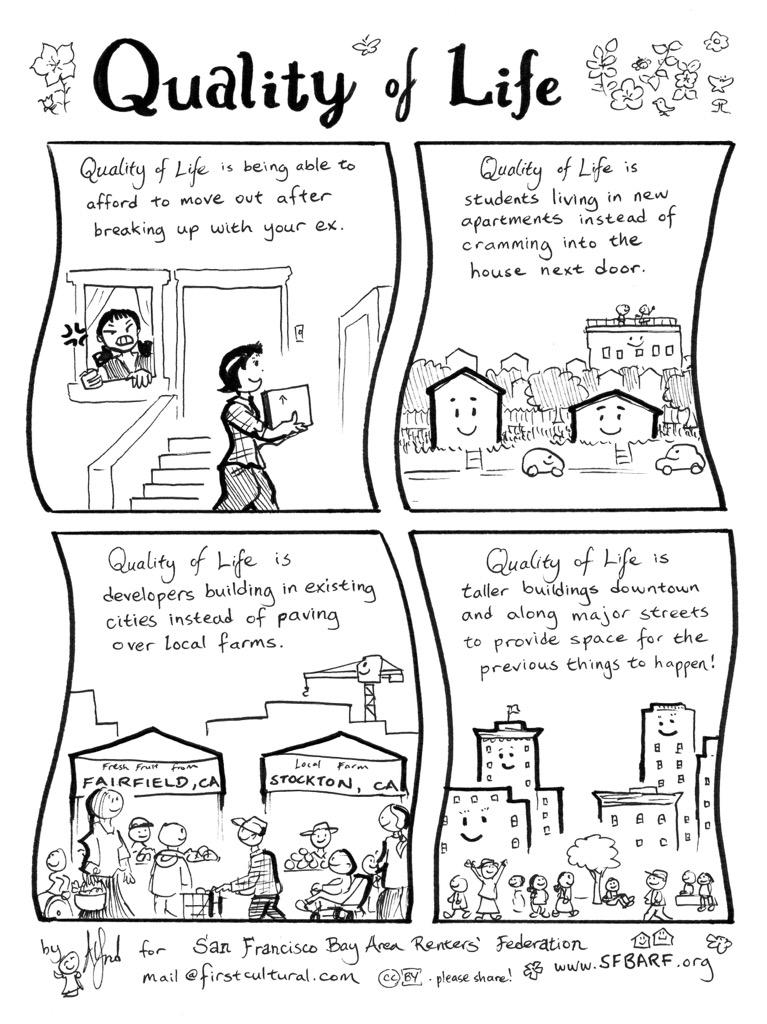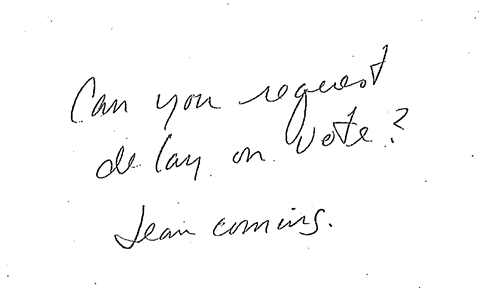California Report: Density Can Mean Affordability
Another gem from the recently released report on expensive housing in California: density means lower prices. Again, this isn’t a shock to many of us, but growth resisters have made density and supply dirty words. They aren’t, and in fact the report from California’s independent and non-partisian Legislative Analyst’s Office building more housing and dense housing is part of the answer to lowering prices. Here’s why:
High Land Costs Can Be Offset Through Dense Development. Although high land costs can translate into higher home prices and rents, it is possible to offset the effects of high land costs through more dense development. (The density of housing refers to the number of housing units per unit of land—typically measured in units per acre. Higher- density housing, such as an apartment building, has more housing units per acre.) Building more units on the same plot of land allows a developer to spread land costs across more units, lessening the impact of land costs on the cost of each unit. This is because land costs are fixed and do not increase if a developer builds additional units. For example, if a developer builds five homes on a plot of land that costs $100,000, the land cost per unit is $20,000. Alternatively, if the developer builds ten homes on the same plot of land, the land cost per unit is only $10,000. Builders faced with high land costs, therefore, generally will build more dense housing. When this occurs, the effect of high land costs on home prices and rents is reduced.
This is why microhousing worked so well; more, smaller units mean cost sharing between renters and lower prices for the same land, construction, and financing costs. It’s like 20 people going to dinner and splitting the bill for the same amount of food instead of 10 people paying for the same dinner; more people means smaller portions but spending less money. It’s that simple. But what makes doing this impossible? Neighborhood opposition, of course.
Community Decisions Can Exacerbate Land Scarcity. City and county land use policies can alleviate pressures created by limited vacant land by encouraging redevelopment and allowing developers to build more housing on each parcel. In many California communities, however, for reasons discussed earlier the opposite is true. Zoning laws often require developers to build housing at densities that are common elsewhere in the community, preventing developers from building at higher densities to counter high land costs. In addition, local communities sometimes pressure developers to reduce a project’s planned density during approval processes. Cities and counties also can magnify the effect of scarce land on housing costs by choosing to allocate a large share of available land to nonhousing uses, such as retail and hotel development.
How long will it take for local officials to get the message from California, a state struggling with the highest housing costs in the nation? I don’t know, but the LAO report is a clear call to allow more housing. Will we heed the warning before we catch up with California?
California Report: Why We Won’t Quit Housing Fight
An extensive report on the high price of housing in California was released last week by that State’s Legislative Analysts office. It’s conclusions will not be surprising to those of us advocating for more housing at all levels of income. California housing prices are the highest in the nation. Why are California prices so high?
Building Less Housing Than People Demand Drives High Housing Costs. California is a desirable place to live. Yet not enough housing exists in the state’s major coastal communities to accommodate all of the households that want to live there.
That’s right, an independent state agency just said that, yes, it’s true, when there isn’t enough housing, prices go up. And why is there not enough housing?
In these areas, community resistance to housing, environmental policies, lack of fiscal incentives for local governments to approve housing, and limited land constrains new housing construction.
So as one writer points out, it is NIMBYs that create the problem. I get sick and tired of hearing NIMBYs say that they aren’t NIMBYs. People who are adding more process, hoops, rules, fees, and other barriers to creating housing realize what they’re doing but desperately want to avoid taking responsibility for the consequences of making it harder to build. “We’re not NIMBYs,” they say,” we just want good growth.” But the report is pretty clear that whatever you call it, making it harder to build doesn’t make housing less expensive. It makes things worse.
And who bears the greatest burden of the housing shortage? Where is the pain felt most in California?
A shortage of housing along California’s coast means households wishing to live there compete for limited housing. This competition bids up home prices and rents. Some people who find California’s coast unaffordable turn instead to California’s inland communities, causing prices there to rise as well.
So the shortage causes bidding up of prices. This is what we have been saying over and over again to sometimes very little effect. When we clamp down on supply in a geographic area, or on the supply of certain types of housing, or lengthen the entitlement process the ensuing shortage means prices go up. But it also means more competition between households for housing, a contest wealthy people always win.
Some people think that I am harsh in my criticism of people pushing for more regulation of housing. What I think some people believe is that we ought to bargain with opponents of new housing; this is something I’m not willing to do. First, as the report makes clear, escalating prices indicate a shortage, and that means we need more. Housing is not a bad thing and too much of it, even if that was possible, favors the renter and the family trying to find housing. Do we really want to sacrifice much needed units to pacify a change resistant faction of the community? I don’t see any benefit to doing that, especially to poor families.
Second, I won’t relent in my efforts to stop people who claim that they are acting for justice or for “good design” or for “good density” from writhing out of the consequences of what they are doing. It’s wrong, and they know it. Is that harsh? I suppose it is.
What’s really harsh is trying to find a place to live that is reasonably priced and not being able to find it because somebody already here as erected a barrier to entering into the market. If I make the comfortable opponent of housing uncomfortable or an elected official feel bad by calling them out for that, I’m not sorry. In fact, it’s my job. If that makes us controversial I don’t care. Someone has to push back so that Seattle doesn’t become more like California, the state with the most expensive housing in the country. We won’t stop doing that.
Art from San Francisco Bay Area Renters Federation (SFBARF)
City Builder: Roosevelt Can Have Housing, Open Space, and Sustainability
Wow. What a difference a week makes. One week ago I stood feeling helpless, frustrated, and angry as I watched our Mayor, City Attorney, and two Councilmembers promise Roosevelt neighbors a park where we had fought for housing. Today, after a week of spontaneous discussion and brain storming, there is a petition circulating on the City Builders Facebook page with ideas to get housing and open space. I feel a lot better. And it all happened collaboratively on social media. What follows is the petition signed by about 30 people but thought sourced by over 200 comments on the City Builder page. I think we have a chance to turn this around. I hope you’ll join us.
———
March 18, 2015
To: Mayor Murray, Seattle City Council Members, and the City Attorney Pete Holmes.
From: City Builders
Re: Parks Proposal in Roosevelt
We are writing about the announcement on March 13, 2015 of the City’s plan to seize a portion of the Sisley properties on the west side of 14th Ave NE between NE 65th and 66th Streets and create a new public park. The following issues are important to acknowledge and have, we believe, widespread consensus:
- The properties are currently a blight and an eyesore to the community,
- Your efforts to secure this land for community purposes are laudable, demonstrate innovative vision and a willingness to take bold action,
- We recognize and support the community process and hard work of numerous community members, advocates, Sound Transit and City employees that led to the zoning designation of these parcels of NC2P-65, and
- We acknowledge the investment of the City in Sound Transit’s Link Light Rail station and the positive effects that investment will have on the Roosevelt neighborhood as well as the impacts of additional residents, and
- Affordable housing is a Public Good of which the City unquestionably needs vastly more,
- Other progressive jurisdictions (e.g. Amsterdam, Stuttgart, Helsinki, Vienna) use long term leases and land trusts to remove land from the speculative market and provide permanently affordable housing to their citizens,
- We acknowledge the nexus between social justice and climate change, and remind the recipients of this letter of the City of Seattle’s commitment to be carbon neutral by 2050 and that buildings emit approximately 26% of Seattle’s carbon emissions, and
- We recognize that the Passive House (Passivhaus) standard of energy conservation is an internationally proven, widely adapted approach to reducing energy used in the heating and cooling of buildings by 90%, as well as providing a more durable, comfortable and healthier building than conventional construction with marginal increase in initial capital cost,
Therefore, we the undersigned, propose and endorse that,
1) The City allocate the parcels in question to affordable housing, in perpetuity, for families earning less than 50 percent of Area Median Income (AMI) through either a long-term (99-year) lease or the establishment of a land trust, and
2) The City designate that the parcels shall be used to create Seattle’s first multifamily Passivhaus building, developed by one of Seattle’s non-profit housing corporations, selected by a public competition, and
3) The Right-of-Way of 14th Ave NE between NE 65th and 66th Streets be vacated and a new innovative green multiuse public open space created on that land, designed in conjunction with and in support of the proposed multi-family developments to the west and east.
Sincerely
City Builders[1]
| Charlie Cunniff | Ben Schiendelman |
| Dan Bertolet | Joel Sisolak |
| David Neiman | David Moser |
| Matt Gangemi | Paul Byron Crane |
| Rob Harrison | Roger Valdez |
| Owen Pickford | Josh Mahar |
| Zachary Pullin | Keri Fowles Williams |
| Rae Anne Rushing | Erik Schwab |
| Zach Shaner | Kim Mulligan |
| Jon Clarke | Will Green |
| Ed Hodapp | Michael Maddux |
| Patti Southard | Ben Ahrens |
| Craig Ratchford | Nick Etheredge |
| Joe Wolf | David Sucher |
| Michael Eliason
Ryan Carson Craig Ratchford |
Dale Jonathan
Bryan Fiedorczyk Alex Steffen |
[1] City Builders is a meet up group and Facebook group of people that share a common interest in housing, land use, and policy that makes our city a better, more sustainable place to live, work, and play. These are supporters as of March 18, but signature gathering on social media and elsewhere is ongoing.
City Builder: Embracing a city’s history, while building upon it
On the top of Queen Anne—a neighborhood comprised of stately homes and a quaint, bustling downtown—is an urban village that is the new home to a 140,000 square foot mixed-used development designed by Tiscareno Associates.
It’s a balancing act that many builders and developers are carefully working to manage. How to increase the usability of the limited space within the city, without losing the spirit of the places we all know and love?
The anchor tenant on the top of Queen Anne hill is the new location for Seattle’s very first Trader Joe’s, which had outgrown its previous Queen Anne location. Although the new building replaced the historic 1920s Elfrieda Building, Tiscareno Associates’ design keeps the character of the building intact while also enhancing the community aspect of the neighborhood.
 The LEED silver Queen Anne Towne incorporates a total of 37,000 square feet of retail space, 105 new apartments and two live/work units, one corner of which is fronted by a façade of bricks taken from the original Elfrieda building. The building shape forms around a new 3,500 square foot plaza at street level that is open to the public. The plaza was designed to both celebrate the area’s history and actively draw pedestrians into the space.
The LEED silver Queen Anne Towne incorporates a total of 37,000 square feet of retail space, 105 new apartments and two live/work units, one corner of which is fronted by a façade of bricks taken from the original Elfrieda building. The building shape forms around a new 3,500 square foot plaza at street level that is open to the public. The plaza was designed to both celebrate the area’s history and actively draw pedestrians into the space.
This is accomplished by focusing the building’s plaza around a delightful bronze sculpture by Georgia Gerber, the artist famous for the pig at Pike Place Market. The sculpture is a playful, larger puppy with a ball which has already proven to be selfie-central for passers-by of all ages. To reference the rich history the neighborhood was founded upon, the eye is drawn down where pedestrians and shoppers will find themselves standing on artistic renderings of historical scenes and an actual map of the neighborhood that is a part of the plaza’s paving pattern. The “You are here” location on the map is marked by a modern version of a spar pole, a tool used by pioneer logging crews on steep slopes. Past, meet present.
The Seattle Office of Financial Management projects the county’s population will grow to about 2.4 million by 2040. That’s a half-a-million more people over the next 25 years for a city that already feels like it’s bursting at the seams. But grow and build we must, which although cheering news for developers and builders, can cause dismay among long-time residents unused to such a fast pace of change. Creating a new history, even while acknowledging the city’s roots has made Tiscareno Associates’ Queen Anne Towne a welcome addition to our ever-changing city and this growing neighborhood.
Will the Seattle City Council Redline the Homeless?
A couple weeks ago the Seattle City Council engaged in some political intrigue around the passage of legislation out of committee allowing homeless encampments in parts of the city. The problem? A proposal from Councilmember Sawant to study allowing the so called “tent cities” in residential areas was scuttled by Councilmember Tim Burgess. Burgess, the President of the Council, helped Jean Godden, who is not a member of the committee considering the proposed amendment, to show up just in time to vote “no” on the study. Now according to Council rules, any Councilmember can attend a meeting, but it is very unusual. And in this case it was clear that single-family interest prevailed again over efforts to look at widening the options for homeless shelter and housing.
We’ve seen this before with small-lot legislation, microhousing legislation, low-rise legislation, and now the single-family voting block has again motivated against some of the city’s most vulnerable and poor people. And after all, it is just a study. Why not take a look at how more homeless shelter options could be created in residential areas? There is still a chance that the full Council could revisit the idea of the study. They should and this is the letter we sent in support of Councilmember Sawant’s idea of just studying the idea that all of Seattle–even single-family neighborhoods–should be part of the solution that would reduce or end homeless in our city.
March 15, 2015
Dear Council President Burgess and Mayor Murray,
I am writing you in support of efforts by Councilmember Sawant to add a study of tent cities in residential areas. Here’s what a tent city resident said in testimony to the City Council on this subject:
We have examined the encampment bill, and we must oppose it because it redlines homeless people out of residential areas. Sending people to live in [non-residential] areas only is wrong. 40 years ago we got rid of racial redlining, we don’t need to return to those days by redlining the homeless now.
As I have said before when I wrote in support of the Urban Rest Stop in Ballard, every square foot of this city must be considered as part of our housing solution. While Councilmember Sawant’s proposed study may find that residential areas won’t work for homeless shelter solutions, we think you must fully explore this potential.
To consign people seeking shelter options to far-flung and hard to reach areas will act as a disincentive for them to seek these options out and be self-defeating. Why deny organizers of tent city the option to work with local neighbors who might be willing to welcome transitional shelter for people who are currently homeless. And, as we have seen with tiny house solutions in Eugene[1] and in Olympia[2], there are viable options to solve the problem of people without homes in Seattle.
As has been correctly pointed out, Seattle is a city that seems to love studies and process. Why not allow a study and process around where we can find an opportunity together, as a community, to create innovative shelter and housing solutions to reduce the human toll of homelessness? I can’t think of a single sensible reason not to include Councilmember Sawant’s proposal to study this. Can you? Please allow the amendment to be voted on in full Council and pass it unanimously.
Sincerely,
Roger Valdez
Director
[1] Opportunity Village, Eugene, Oregon, http://www.opportunityvillageeugene.org/
[2] Quixote Village, Olympia, Washington, http://quixotevillage.com/







